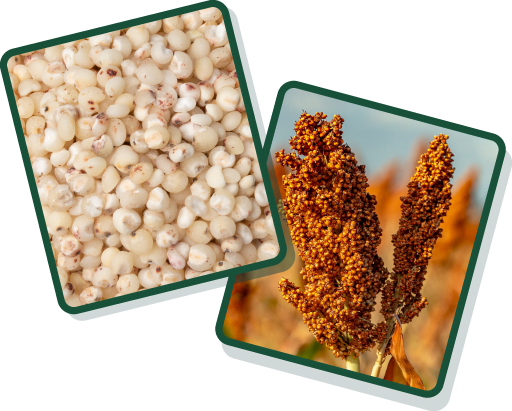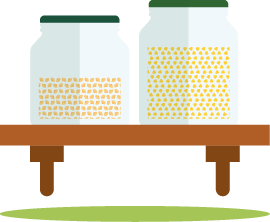
Whole sorghum is a whole grain with a mild, slightly sweet flavour and a tender, chewy texture. It is widely used in African and Indian cuisines, often in porridges, flatbreads, and as a grain in pilafs and salads. Sorghum flour works also well in pancakes, waffles, crepes, and cookies.
Sorghum has a sweet taste and pairs especially well with ingredients such as ham, bourbon, pecans, peanuts, berries, dates, figs, banana, and warm spices. Toasting whole sorghum before cooking can add a deeper, nuttier flavour, and using broth instead of water can enhance the dish's richness.

Nutritionally, whole sorghum is high in fibre, magnesium, phosphorus, thiamine (vitamin B1), and vitamin B6. It’s also a source of potassium, iron, zinc, copper, and niacin (vitamin B3). It also contains antioxidants like phenolic compounds and is gluten-free, making it suitable for those with gluten intolerance or coeliac disease.
The phenolic compounds in whole sorghum have strong antioxidant properties, which can reduce inflammation and protect against chronic diseases. Sorghum’s protein content also makes it a good option for those following a plant-based diet.

Toggle with the tables below to compare their nutritional content per 100 g (both cooked and uncooked) and per average portion size. You might be surprised by the differences!
| Grains | Kcal | Protein | Fat | Saturated fat | Carbohydrates | Fibre |
|---|---|---|---|---|---|---|
| Whole sorghum, Per 100 g, uncooked | 329.00 | 10 | 3 | 0 | 72 | 6 |
Whole grains are all packed with carbohydrates and dietary fibre (which is a type of carbohydrate) and are naturally low in (saturated) fat. Fibre is important for our health and the prevention of many chronic diseases. That’s why the European Food Safety Authority (EFSA) recommends we eat at least 25 g of fibre per day. Sometimes, you might see whole grains labelled as ‘high in fibre’ or ‘source of fibre’ – but what does that really mean?
| Grains (% of DRV) | Calcium | Magnesium | Phosphorus | Potassium | Iron | Zinc | Copper | Vit. B1 | Vit. B2 | Vit. B3 | Vit. B6 | Folate |
|---|---|---|---|---|---|---|---|---|---|---|---|---|
| Whole sorghum, per 100 g, uncooked | 1.63 | 44.00 | 41.29 | 18.15 | 24.00 | 16.70 | 28.40 | 30.18 | 6.86 | 23.06 | 31.64 | 6.06 |
| Whole sorghum, per portion, uncooked | 1.14 | 30.80 | 28.90 | 12.71 | 16.80 | 11.69 | 19.88 | 21.13 | 4.80 | 16.14 | 22.15 | 4.24 |
% of DRV stands for dietary reference value. DRV stands for dietary reference value. These values estimate how much of a nutrient most healthy people in Europe need each day. Ideally, we should aim to reach 100% of these values daily. Each vitamin and mineral has their own DRV, as set by EFSA.
You might have heard that whole grains are ‘high in,’ ‘rich in,’ or ‘source of’ a certain vitamin or mineral. These term are regulated by EFSA and products must meet specific rules to be considered as such. Here’s how to interpret these contributions:

Store in an airtight container in a cool, dry place. Follow the instructions on the packaging to keep the food good for as long as possible.
Whole sorghum has a best-before date, meaning that it can often be eaten after that date has passed. If they look, smell and taste good, and the packaging is also intact, it will most likely be safe.

Follow the instructions on the packaging to cook sorghum. Cooking times can vary depending on the variety and type of sorghum.
As a general rule of thumb, to cook whole sorghum, rinse it in a fine-mesh strainer. Then, add 1 part of whole sorghum to 3 parts of water or broth in a pot. Bring to a boil, then reduce heat, cover, and simmer for 45-60 minutes, until the sorghum is tender, and the liquid is absorbed. Fluff with a fork before serving.

Pearl sorghum, which has had the outer layers removed, is not a whole grain. Whole grain sorghum retains all the edible parts of the grain, including the bran, germ, and endosperm.
Learn to identify whole grain products, cook delicious meals, find practical tips for a smooth, gradual switch, and much more!